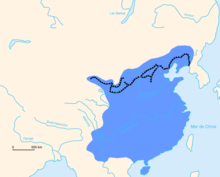Real China

The actual China , alternatively closer China or inner China ( Chinese 中國本土 / 中国本土 , Pinyin Zhōngguó běntǔ ), is in the western Sinology used to denote those regions of China, which in the Chinese history never for a long time from the Chinese empire dissolved were. Outside the actual China are the historical Chinese sub-countries Xinjiang , Inner and Outer Mongolia , Tibet , Qinghai and Manchuria .
The 18 provinces
The term 18 provinces , which have covered the area of actual China since the end of the 18th century , is used largely synonymously . These are the following provinces (with the exception of Zhilis) that still exist today:
Definition
The term “Inner China” is a modern one and best describes the situation during the Qing Dynasty of the 18th and early 19th centuries. The Tang Dynasty ruled interior China and for a time larger parts of Manchuria and Central Asia. The Song dynasty , on the other hand, only ruled Inner China and ultimately only partially ruled it. The Yuan Dynasty added the northeast, parts of Siberia, Mongolia, and Yunnan to the rule area. The Ming Dynasty claimed Yunnan and parts of the northeast, but not Mongolia and Siberia. China reached its greatest expansion under the Qing Dynasty.
Status of Taiwan
Recently, against the background of the Taiwan conflict, there have been disputes over the question of whether the island of Taiwan is part of interior China. In particular, many Taiwanese publicists and politicians, as well as some historians, deny this. The island was incorporated into the Qing Dynasty Empire relatively late in 1683 . It was initially assigned administratively to the province of Fujian, one of the inner provinces of China. However, for a long time large parts of the island were not under effective control of the Qing, but ruled by indigenous Austronesian peoples . Structurally, Taiwan was more like an external possession, such as Xinjiang , so the arguments of the historians. However, this can be countered by the fact that Taiwan, in contrast to many other “outer provinces”, gained a Han-Chinese majority of the population early after the Chinese occupation through immigration and thus became part of the Chinese cultural area. When the threatened annexation of the island by imperialist foreign powers became apparent, Taiwan was raised to one (the 19th) province in 1887 in order to consolidate its affiliation with China. But it only had this rank for 8 years until it was actually annexed by Japan in 1895.
Similar or complementary terms
Han China

Inner China is largely identical to the historical core settlement area of the Han ( 漢 地 / 汉 地 , Hàndì - "Han soil"). The two southern provinces of Yunnan and Guangxi play a special role , as non-Han peoples make up a significant proportion of the population here. This is one of the reasons why some authors do not count Yunnan as part of Inner China.
Greater China
The term "Greater China" (English. Greater China ) can be seen as complementary concept to the interior of China. However, the term is much less clear than that, as it has been and is used in many different contexts. It can be meant in a territorial sense and z. Including the People's Republic of China and Taiwan, or even in a maximal sense the whole area of the former Qing Empire. It can also be understood culturally and, in addition to core China, designate Chinese culture abroad - in Southeast Asia, Australia, the United States, Canada, etc.
Individual evidence
- ^ William T. Rowe: China's Last Empire. The Great Qing (= History of Imperial China. Volume 6). Harvard University Press, Cambridge 2009, ISBN 978-0-674-03612-3 , p. 31.
- ↑ a b Wilhelm Schüler: Outline of the modern history of China with special consideration of the province of Shantung . Curtius, Berlin 1912 ( PDF file; 8.2 MB ), pp. 346–366.
- ↑ a b c d Pamela Kyle Crossley: The Wobbling Pivot, China since 1800: An Interpretive History . Wiley-Blackwell, 2010, ISBN 978-1-4051-6079-7 , Chap. 4 Essay : Strategic Borders, pp. 66 (English).
- ↑ Taiwan has never been China's. Taipe Times, March 2, 2018, accessed December 31, 2018 .
- ^ Harry Harding: The Concept of "Greater China": Themes, Variations and Reservations . In: The China Quarterly . tape 136 . Cambridge University Press, December 1993, pp. 660-686 , JSTOR : 655587 (English).
- ^ Wang Gungwu: Greater China and the Chinese Overseas . In: The China Quarterly . tape 136 . Cambridge University Press, December 1993, pp. 926-948 , JSTOR : 655597 (English).